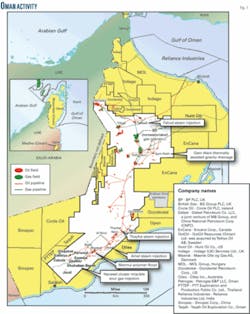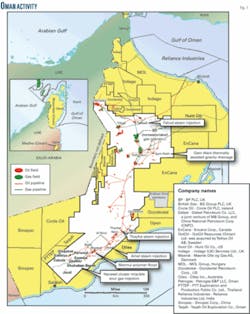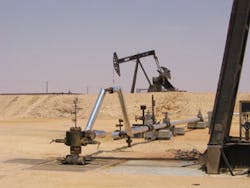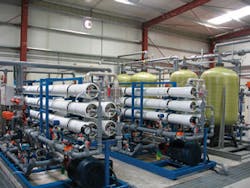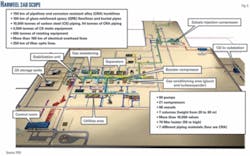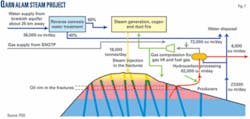To sustain long-term oil production from its contract area in Oman, Petroleum Development Oman has turned to diverse methods for enhancing oil recovery from its fields that contain many billions of barrels of oil in place.
Without these investments, PDO expects ultimate oil recoveries from these fields would range between 4 and 20%. But depending on the EOR method employed, ultimate recoveries could increase to as high as 50%.
The company’s first EOR projects will be in fields near Nimr, around Harweel, in Qarn Alam, at Marmul, and at Fahud (Fig. 1).
Near Nimr, PDO started injecting steam on Sept. 10, 2007, in a pilot project in Amal West field and will also begin steam pilots in Amal East and Thayfut. Also it is studying the potential of in situ combustion in a shallow reservoir containing 300-700 cp oil in Nimr.
The company also has under way facility construction for injecting miscible sour gas into a cluster of fields near Harweel.
At Qarn Alam, PDO in early 2007 let contracts for constructing facilities for a thermally assisted gas-oil gravity drainage (TAGOGD) project in a heavy-oil fractured carbonate reservoir.
Another contract let in 2007 was for facilities for injecting polymer in a heavy oil reservoir at Marmul.
At Fahud, the EOR process, also TAGOGD, will involve injecting steam to accelerate recovery of light oil from a fractured carbonate.
PDO is owned by the Omani government, 60%; Royal Dutch Shell PLC, 34%; Total SA, 4%, and Partex Oil & Gas Group, 2%.
Nimr area
PDO is initiating three steam injection pilots in fields in the Nimr area (Fig. 1) that will assess the process for recovering heavy oil from thick sandstone reservoirs in Amal West, Amal East, and Thayfut fields. Steam injection in a well at Amal West started in September 2007 (Fig. 2).
PDO designed the pilots to calibrated simulation models for designing the projects, although a pilot in Amal East in the late 1980s and early 1990s provided it with enough information to feel confident that steam injection is feasible in the fields, Amour al Suqri, the head of engineering construction for the Nimr projects, told OGJ during a recent visit to the site.
The company plans to complete full field steam-injection facilities in 2010 and later in 2013 add a power plant for providing additional heat for steam generation.
The Amal fields produce a 20-22° gravity heavy oil from beam pumped wells with depths that vary from 500 to 1,000 m.
PDO constructed an 800 cu m/day water treatment plant for the Amal West and Amal East pilots. The plant includes a GE reverse-osmosis process that lowers total dissolved solids in the feed water to 50 ppm from 4,000 ppm (Fig. 3).
Two skid-mounted 200 ton/day portable gas-fired steam generators provide the steam (Fig. 4).
The Amal West pilot was a fast track 18-month project from initial assessment to steam injection. PDO said it initiated the project in first-quarter 2006, with approval given in third-quarter 2006, and detail design started in first-quarter 2007.
The Amal West pilot has three wells on cyclic injection that will have steam injected in them for 1 month, followed by 1 week of soaking, and 3-5 months of production. PDO expects the full-sized project in Amal West to involve continuous steam injection with wells on seven-spot, 10-acre patterns.
For the Amal East pilot, PDO plans to move one of the 200 ton/day steam generators from Amal West. The pilot also will use three wells.
Al Suqri said the reservoir in Amal East is deeper, so that higher pressures will be needed to inject steam. The reservoir is about 200-m thick.
For the full-scale project, the company expects Amal East to remain on cyclic steam injection until the reservoir heats up sufficiently for continuous steam injection.
PDO also plans to inject steam at Thayfut. Its pilot involves 1 well on continuous steam injection and cyclic steam injection in four other wells.
The wells are at 900-1,000 m depths. Steam injection will be 200 tons/day.
PDO also has under evaluation an in situ combustion project in a shallow reservoir containing 300-700 cp oil in Nimr. The reservoir contains heavy 20° gravity oil and has strong aquifer support.
Harweel
In the south of Oman, PDO has under construction the facilities for the Harwell Phase 2AB miscible sour-gas injection project (Figs. 5 and 6). PDO awarded the engineering, procurement, and construction (EPC) contract in December 2005 and expects to finish construction in 2010.
PDO discovered Harweel in 1997 and since has found seven similar fields containing intrasalt carbonate stringers in a large 1,000 sq km area. The company estimates that the cluster of fields contained an initial 1.8 billion bbl in place of light sour oil and retrograde condensate. The fields in the cluster include Shujirat, Sakhiya, Harweel Deep, Sarmad, Ghafeer, Dafiq, Dhahaban South, and Zalzala
The oil has a 38-50° gravity and a 300-400 cu m/cu m GOR. The associated gas contains about 5-10% CO2 and 5% H2S.
The reservoirs are at a 3-5 km depth and have a high 7,000-14,000 psi pressure. The stringers commonly have a low 0.1-10 md permeability.
PDO has drilled more than 60 wells in these fields and in Phase 1 has produced oil from four fields and injected gas in the Zalzala field to confirm the viability of miscible sour-gas injection.
During Phase 1, PDO produced about 18,000 bo/d from the Harweel cluster of fields. But production could increase to more than 100,000 bo/d once the Phase 2AB project is finished.
“The crude oil found in the cluster is some of the oldest on earth,” said Harweel Project Manager Ian R. Hill during an interview at PDO headquarters in Muscat.
Hill estimates a 10% ultimate oil recovery without miscible sour-gas injection that may increase to more than 30% with injection.
In 2005, PDO signed a $1 billion EPC contract with Petrofac for an oil and gas processing station as well as gas-injection facilities near Harweel for the full-scale EOR project. Petrofac is executing the work from its Sharjah base in conjunction with Galfar Engineering & Contracting, an Omani company.
The central processing facility will include one of the highest-rated, largest-capacity gas-injection compressors in the oil industry.
The Harweel facilities will process very corrosive fluids, so that much of the installed equipment and piping is made from corrosion-resistant alloys.
Zalzala field will be first to go on stream once the full-scale EOR project begins. The Sakhiya and Dafaq fields will be added later, although both will be on primary production before miscible sour-gas injection starts.
Qarn Alam
PDO discovered Qarn Alam in 1972 and estimates that initial oil in place in the field’s fractured carbonate reservoir was 1 billion bbl. The field produces heavy 16° gravity, viscous 220-cp oil. Without the thermal project, PDO estimates only a 4% ultimate oil recovery from the field. But with its thermally assisted gas-oil gravity drainage (TAGOGD) project ultimate recoveries may exceed 32%, according to the company.
Qarn Alam Project Manager Rik Hofland told OGJ a steam pilot during 1998-2003 proved out the injection concept. The TAGOGD process involves injecting steam into the formation’s fractures to heat the low-permeability oil-bearing rock (Fig. 7). The heat liberates gas that reduces the oil viscosity, allowing the oil to flow easier.
Hofland says the fractures serve as conduits for both the injected steam and the produced oil, but unlike a conventional steam-injection project, in which the steam serves to drive oil to producing wells, the steam at Qarn Alam provides heat to enhance the existing gravity drainage mechanism. This feature allows the project to have only a few injection wells.
The company’s plan is to inject during the next 30 years 18,000 tonnes/day of steam and have a plateau production during 10 years of about 30,000 bo/d.
The project involves drilling 149 new wells that include:
- 69 water supply, aquifer pump off, and water-disposal wells.
- 15 steam injection wells.
- 36 producing wells.
- 29 observation wells.
Earlier in 2007, PDO let two EPC contracts for building facilities for the project.
Facilities will include three heat-recovery steam generators, a 36,000 cu m/day reverse-osmosis plant, and equipment to handle 62,000 cu m/day of gross produced fluid and dispose of 72,000 cu m/day of water.
The project will have 220 km of pipelines and flowlines, along with a power plant.
The main oil-bearing reservoir is the Shuaiba-Kharaib formation that has a dome-shape and a 6 by 3 sq km areal extent. The maximum oil column thickness is 165 m, with the shallow crest of the Shuaiba at 350 m below ground level.
The reservoir has a high 29-34% matrix porosity. Matrix permeablity in the Shuaiba ranges from 5 to 20 md while in the Kharaib it is 1-10 md.
PDO awarded the EPC contract for the on-plot facilities, those erected at the field site, to Dodsal and the off-plot facilities, the oil and water flowlines and associated hardware outside of the field site, to Galfar Engineering & Contracting.
“Most of the steam will be generated by waste-heat recovery from the existing Qarn Alam power station, thereby reducing the project’s CO2 emissions and saving on gas consumption,” said Subsurface Project Team Leader Khalid al Khabouri.
The start-up date of all facilities will be around 2010.
Marmul
Initial production from the Al Khlata sandstone reservoir in Marmul started in 1980, although the field was discovered in 1956. The reservoir was on primary production until a waterflooding started in 1986, with full field waterflooding starting in 1999. Marmul Polymer Project Manager Fakhri al Sukaiti said a polymer project in the 1980s indicated the feasibility of injecting polymer, although subsequent low oil prices led to deferring the project.
Although waterflooding improved recovery, al Sukaiti said that “because the oil is highly viscous (80-90 cp at the 45° C. reservoir temperature), the injected water tended to flow past and leave behind much oil.”
With its planned polymer flood, al Sukaiti expects to obtain 10% more recovery from the field.
Polymer flooding uses polymer to make the injected water more viscous so that it can more effectively sweep the remaining oil from the reservoir. PDO plans to obtain the polymer from France in powder form and ship it to the field in bulk containers.
The injection mixture will have 15 cp viscosity.
PDO, in February 2007, awarded an EPC contract for the Marmul polymer flooding project to France’s SNF with the UK’s Mott MacDonald as design contractor and Oman’s Bahwan Engineering Co. as construction contractor.
The contract involves building centralized water treatment and polymer preparation and injection facilities as well as the supplying chemicals for 5 years. Project completion is scheduled for 2008.
The centralized water-treatment facilities will include a primary produced-water treatment plant with capacity of 80,000 cu m/day and a secondary produced-water treatment plant with capacity of 30,000 cu m/day (Fig. 8).
The polymer preparation and injection facilities station will have a capacity of 17,500 cu m/day.
Fahud
PDO plans to start injecting steam into one reservoir in Fahud in 2008 as part of a pilot project that kicks off another TAGOGD development. Fahud produces 33° gravity oil from the Natih fractured carbonate and is PDO’s oldest and largest field in northern Oman. Discovered in 1963, the company estimates the initial oil in place in the shallow field was 6.3 billion bbl.
The field has about 380 producing wells.
But, as John Malcolm, PDO’s managing director, says, “just because a field has been producing for many years, it does not mean there is no more scope for gaining additional reserves from it. EOR techniques can be applied to it to give it a new lease of life.”
Like the TAGOGD project at Qarn Alam, the one at Fahud will involve injecting steam into the fractures of a carbonate reservoir. But the Fahud project will be the first time ever that the recovery technique is applied to produce a light oil.
PDO made its investment decision on steam injection in September 2006 on the basis of the performance of earlier water-injection projects and a thorough review of the development options for the mature field. To minimize the business risk, the field will be developed according to a prudent phase-by-phase approach.
The company says the oil recovery factor from the field is about 17% and expects steam injection to add 10% to the ultimate oil recovery.
